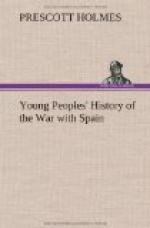We have seen that the fleet sailed Wednesday afternoon, and the next Saturday morning land was sighted—the island of Luzon. On, on, the ships sped, and that evening they reached the entrance to Manila Bay. Then they stole along in the darkness, with their lights covered, so that the Spaniards might not see them. Our men were doing a daring deed. They were entering a strange bay, by night, where not one of them had ever been before; they did not know the soundings, they had no harbor pilot. The entrance to the bay was guarded by fortresses containing big Krupp guns, and there was good reason to think that there were “mines” in the water, which might blow the ships to pieces. Still, every man was ready to do his duty.
[Illustration: The “Olympia,” Admiral Dewey’s Flagship.]
Some of the forts did discover our ships, and fired a few shots; but no harm was done, and our ships steamed on. At daybreak they drew near the city of Manila. The Spaniards were expecting them, having had notice of their approach. The Spanish ships, under Admiral Montojo, were waiting at a place called Cavite, seven miles from Manila. They were protected by batteries on the shore. Having steady guns on the shore should have been a great help to the Spaniards, as it is easier to fire a steady gun than to fire a gun on a ship that is riding up and down on the waves.
[Illustration: Battle of Manila Bay.]
The battle began a little after five o’clock, Sunday morning, May 1st, 1898. The Spaniards fired the first shot. All the vessels of our fleet were out in the bay, but, as soon as the Spaniards began to fire, our fighting ships started forward. They did not answer the Spanish fire at first, but steamed up the bay, in a wide circle, toward the city of Manila, then turned and came back toward Cavite. The Olympia led the way. After her came the Baltimore, Raleigh, Concord, Petrel, and Boston. All had their battle-flags flying.
[Illustration: Admiral Montojo.]
Uninjured by the enemy’s shots, the Olympia and her train drew near the Spanish forts and ships. At a distance of a little more than four thousand yards, the Olympia fired, and the roar of her first gun was the signal to her companions to open fire. Then the firing from both sides became fast and furious. Our ships moved rapidly about, up and down, past Cavite five times. Admiral Montojo came out in his flagship, the Reina Christina, to attack the Olympia. The Olympia poured such a storm of shot at her that she was compelled to turn back toward the harbor. But the Reina Christina had met her doom. As she turned, a huge shell from the Olympia struck her, set her on fire, and killed her captain and many of her men. Admiral Montojo changed his flag to another ship and came forward again, but soon had to turn back. But a moment of great peril came to the Olympia. Two fierce little torpedo-boats came toward her, ready to hurl her to destruction. The gunners of the Olympia instantly opened such a shower of shells from the smaller guns that the surface of the water was covered with foam. The little boats, without having had time to send forth a torpedo, were overcome. One of them blew up, then sank, with her crew, beneath the waves. The other, pierced with shots, turned toward the shore and ran upon the beach, a wreck.




